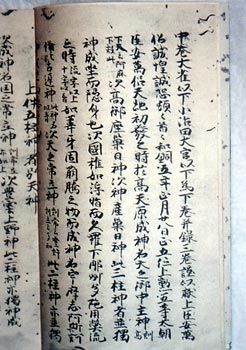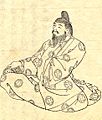Kojiki facts for kids
The Kojiki (pronounced Koh-jee-kee) is the oldest book from Japan. Its full name means Records of Ancient Matters. It was finished in the year 712 CE. This special book was made for Empress Gemmei.
The Kojiki is full of exciting stories about Japanese mythology and the Shinto religion. It mixes tales of gods with legends about the first emperors of Japan, like Emperor Jimmu. Because of this, it's sometimes hard to tell what's real history and what's a legend! A famous legend says that all Japanese emperors came from Amaterasu, the sun goddess.
The Kojiki was written using Chinese characters. But here's a cool fact: the writers used the sound of the Chinese characters, not their meaning, to write Japanese words. This means if you only knew Chinese, you couldn't read the Kojiki unless you also understood Japanese! It has many old Japanese names and phrases.
Contents
The Kojiki's Three Parts
The Kojiki is split into three main parts, like chapters in a book. These are called volumes: the Kamitsumaki (上巻, "first volume"), the Nakatsumaki (中巻, "middle volume"), and the Shimotsumaki (下巻, "lower volume").
Kamitsumaki: The Age of the Gods
The Kamitsumaki is also known as the "Volume of the Age of the Gods." It starts with a special introduction to the whole book. This part tells stories about the very first kami (gods) in Japanese mythology.
It introduces Izanagi and Izanami, who are said to be the gods who created the world. This volume also describes how many other gods were born during the kamiyo period, or the Age of the Gods.
The Kamitsumaki also shares legends about how Japan itself was created. It explains how Ninigi-no-Mikoto, who was the grandson of Amaterasu, came down from Takamagahara (heaven) to Kyūshū. According to this legend, he became the ancestor of the Japanese royal family. He is even considered the great-grandfather of Emperor Jimmu.
Nakatsumaki: Early Emperors and Legends
The Nakatsumaki begins with the exciting story of Emperor Jimmu, who was the first Emperor of Japan. It tells how he conquered Japan and brought different areas together. This volume finishes with the 15th Emperor, Emperor Ōjin.
There isn't much detail about the reigns of the emperors from the second (Emperor Suizei) to the ninth (Emperor Kaika). Only their names and the names of their family members are usually mentioned. We don't hear much about what they achieved.
Many stories in this volume are considered myths. There isn't much proof that they are true historical events. Some experts believe these early emperors might have been invented. This would make Jimmu's reign seem even older, going back to 660 BC.
Shimotsumaki: Later Emperors and Human Stories
The Shimotsumaki covers the stories of the 16th to the 33rd emperors. This volume is different from the first two. It doesn't have many stories about the gods.
In the first two volumes, gods and humans often interact. But in this last volume, those interactions are much less common. Also, information about the emperors from the 24th to the 33rd is largely missing.
Related pages
Images for kids
-
Portrait of Ō no Yasumaro by Kikuchi Yōsai (19th century)
See also
 In Spanish: Kojiki para niños
In Spanish: Kojiki para niños







